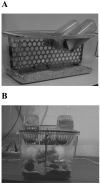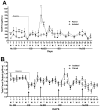Effect of a cage divider permitting social stimuli on stress and food intake in rats
- PMID: 18565550
- PMCID: PMC2562762
- DOI: 10.1016/j.physbeh.2008.04.025
Effect of a cage divider permitting social stimuli on stress and food intake in rats
Abstract
The need to obtain data from individual laboratory animals has forced many researchers to singly-house small animals. This is costly to the researcher and isolation can adversely affect animal physiology and behavior which in turn may threaten the validity and generalization of experiment results to humans. We assessed the practical use of a housing device - dubbed "Buddy Barrier" (BB) - that allows social stimulation in a paired-housing situation while at the same time permitting the collection of individual measures that traditionally require individual-housing. To assess stress responses to the BB, adult male rats were single or pair-housed for several days with and without a BB in the cage. Fecal corticosterone metabolites (fCORT), food intake and body weight were monitored daily. Plasma CORT and adrenal catecholamine levels were assessed at the end of the housing manipulation. Stress hormone measures did not differ in paired vs. singly-housed rats and paired rats quickly habituated to introduction and removal of the BB. Barring a trend for paired rats to eat more in the first 4 h of the dark, there was no difference in 24 h intakes or body weight gain between singly and paired-housed rats. While the BB attenuated 24 h intakes in both groups, intakes normalized to non-BB conditions by the third BB reintroduction. A device such as the BB can enhance the welfare of animals by providing social enrichment without compromising the integrity of experimental protocols traditionally requiring single-housing. In times of lagging research funding it can also substantially reduce housing costs.
Figures




Similar articles
-
Effects of single compared with pair housing on hypothalamic-pituitary-adrenal axis activity and low-dose heroin place conditioning in adult male Sprague-Dawley rats.J Am Assoc Lab Anim Sci. 2014 Mar;53(2):161-7. J Am Assoc Lab Anim Sci. 2014. PMID: 24602542 Free PMC article.
-
Effects of separated pair housing of female C57BL/6JRj mice on well-being.Sci Rep. 2022 May 25;12(1):8819. doi: 10.1038/s41598-022-12846-6. Sci Rep. 2022. PMID: 35614188 Free PMC article.
-
Accurate measurement of body weight and food intake in environmentally enriched male Wistar rats.Obesity (Silver Spring). 2011 Aug;19(8):1715-21. doi: 10.1038/oby.2010.331. Epub 2011 Jan 13. Obesity (Silver Spring). 2011. PMID: 21233804
-
Effect of chronic social stress on delta-opioid receptor function in the rat.J Pharmacol Exp Ther. 1999 Jul;290(1):196-206. J Pharmacol Exp Ther. 1999. PMID: 10381776
-
Home alone: a systematic review and meta-analysis on the effects of individual housing on body weight, food intake and visceral fat mass in rodents.Obes Rev. 2018 May;19(5):614-637. doi: 10.1111/obr.12663. Epub 2018 Jan 15. Obes Rev. 2018. PMID: 29334694
Cited by
-
Adolescent Development of Biological Rhythms in Female Rats: Estradiol Dependence and Effects of Combined Contraceptives.Front Physiol. 2021 Nov 5;12:752363. doi: 10.3389/fphys.2021.752363. eCollection 2021. Front Physiol. 2021. PMID: 35615288 Free PMC article.
-
Investigating individual differences in opioid-taking and opioid-seeking behavior in male rats.Psychopharmacology (Berl). 2022 Apr;239(4):1065-1080. doi: 10.1007/s00213-021-06023-2. Epub 2022 Jan 4. Psychopharmacology (Berl). 2022. PMID: 34981179
-
Effects of Pair Housing on Patency of Jugular Catheters in Rats (Rattus norvegicus).J Am Assoc Lab Anim Sci. 2021 May 1;60(3):357-364. doi: 10.30802/AALAS-JAALAS-20-000071. Epub 2021 Apr 16. J Am Assoc Lab Anim Sci. 2021. PMID: 33863401 Free PMC article.
-
Effects of Extended Cage Component Sanitation Interval on the Microenvironment, Health, and Gastrointestinal Microbiome of Rats (Rattus norvegicus).J Am Assoc Lab Anim Sci. 2023 May 1;62(3):212-221. doi: 10.30802/AALAS-JAALAS-22-000113. Epub 2023 Apr 18. J Am Assoc Lab Anim Sci. 2023. PMID: 37072181 Free PMC article.
-
Effects of Chronic Mild Stress on Cardiac Autonomic Activity, Cardiac Structure and Renin-Angiotensin-Aldosterone System in Male Rats.Vet Sci. 2022 Sep 29;9(10):539. doi: 10.3390/vetsci9100539. Vet Sci. 2022. PMID: 36288152 Free PMC article.
References
-
- Van Loo PL, Van de Weerd HA, Van Zutphen LF, Baumans V. Preference for social contact versus environmental enrichment in male laboratory mice. Lab Anim. 2004;38:178–188. - PubMed
-
- Gonder JC, Laber K. A renewed look at laboratory rodent housing and management. ILAR J. 2007;48:29–36. - PubMed
-
- Fox MW. In: Laboratory Animal Husbandry: Ethology, Welfare and Experimental Variables. Albany NY, editor. State University of New York Press; 1986.
-
- Russell WMS. Shooting the clock: Timeless lessons of the past still guide today’s refinement initiatives. Science and Animal Care WARDS Newsletter. 1997;8:1–2.
-
- Claasen V. Neglected Factors in Pharmacology and Neuroscience Research. Elsevier; Amsterdam, Netherlands: 1994.
Publication types
MeSH terms
Substances
Grants and funding
LinkOut - more resources
Full Text Sources
Medical

